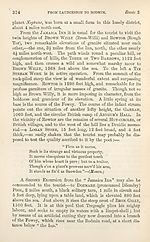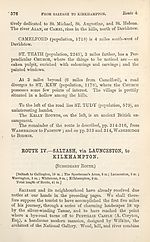Download files
Complete book:
Individual page:
Thumbnail gallery: Grid view | List view

Route 3.
DAVIDSTOW.
375
To resume our route. Eoub Hole Cross is 1£ mile from
the “ Jamaica Inn,” and 12 miles from Launceston. Only two
of the “ four holes” recorded by its name can now he detected in
the cross.
Temple, 3£ miles further, formerly belonged to the knights-
templars, who erected a Church here, long ago suffered to fall
into a melancholy ruin.
1£ mile, Peverell’s Cross, another wayside memorial,
2 miles, The London Inn ; and 4 miles beyond—
21J miles from Launceston—BODMIN [described pp. 291-
294.]
ROUTE III.—LAUNCESTON to PADSTOW.
Or, vid CAMELFORD to BODMIN.
[Da-vidstow, 11 m. ; Camelford, 4 m. ; St. Teath, 3 m. ; St. Kew, 3 m.; Wade-
bridge, 5 m.; Padstow, 8 m.; or, from Wadebridge, vid Egloshayle, to Bodmin, 7 m.
Total length of Route, 34 m.—(Padstow.)
Our route carries us, if we may use the expression, through
the borough of Newport, across the Kinsey, and past the fine old
church of St. Stephen’s (near the diverging point of the Kilk-
hampton road, and 1 mile from Launceston). It then turns to
the westward, following the river-course, and at 3 miles passes
(on the right) EGLOS KERRY (population, 431), a quiet village
very prettily situated, and crossing the country by way of
TRESMEER (population, 175), joins, near the eighth milestone
from Launceston, the regular high road pursued by the mail
coaches. The latter route is nearer, but through a less pictur¬
esque and far more hilly country, and passing—we might almost
say avoiding — the villages of Trewen, Laneast, and St.
Cleather.
DAVIDSTOW (population, 410), pronounced Dewstow—
whose rector, the Rev. J. Glanville, bears a true Cornish name—
is a squalid village with an interesting Church. The soil in
the neighbourhood is churlish and barren, and a broad tract of
moorland stretches far away to the south, which is as profitless
to the agriculturist as it is cheerless to the wayfarer. It is said
that this poor parish could once boast of three chapels, respect
DAVIDSTOW.
375
To resume our route. Eoub Hole Cross is 1£ mile from
the “ Jamaica Inn,” and 12 miles from Launceston. Only two
of the “ four holes” recorded by its name can now he detected in
the cross.
Temple, 3£ miles further, formerly belonged to the knights-
templars, who erected a Church here, long ago suffered to fall
into a melancholy ruin.
1£ mile, Peverell’s Cross, another wayside memorial,
2 miles, The London Inn ; and 4 miles beyond—
21J miles from Launceston—BODMIN [described pp. 291-
294.]
ROUTE III.—LAUNCESTON to PADSTOW.
Or, vid CAMELFORD to BODMIN.
[Da-vidstow, 11 m. ; Camelford, 4 m. ; St. Teath, 3 m. ; St. Kew, 3 m.; Wade-
bridge, 5 m.; Padstow, 8 m.; or, from Wadebridge, vid Egloshayle, to Bodmin, 7 m.
Total length of Route, 34 m.—(Padstow.)
Our route carries us, if we may use the expression, through
the borough of Newport, across the Kinsey, and past the fine old
church of St. Stephen’s (near the diverging point of the Kilk-
hampton road, and 1 mile from Launceston). It then turns to
the westward, following the river-course, and at 3 miles passes
(on the right) EGLOS KERRY (population, 431), a quiet village
very prettily situated, and crossing the country by way of
TRESMEER (population, 175), joins, near the eighth milestone
from Launceston, the regular high road pursued by the mail
coaches. The latter route is nearer, but through a less pictur¬
esque and far more hilly country, and passing—we might almost
say avoiding — the villages of Trewen, Laneast, and St.
Cleather.
DAVIDSTOW (population, 410), pronounced Dewstow—
whose rector, the Rev. J. Glanville, bears a true Cornish name—
is a squalid village with an interesting Church. The soil in
the neighbourhood is churlish and barren, and a broad tract of
moorland stretches far away to the south, which is as profitless
to the agriculturist as it is cheerless to the wayfarer. It is said
that this poor parish could once boast of three chapels, respect
Set display mode to:
![]() Universal Viewer |
Universal Viewer | ![]() Mirador |
Large image | Transcription
Mirador |
Large image | Transcription
| Antiquarian books of Scotland > Adventure and adventurers > Black's guide to the counties of Dorset, Devon, & Cornwall > (420) |
|---|
| Permanent URL | https://digital.nls.uk/142591419 |
|---|
| Description | Thousands of printed books from the Antiquarian Books of Scotland collection which dates from 1641 to the 1980s. The collection consists of 14,800 books which were published in Scotland or have a Scottish connection, e.g. through the author, printer or owner. Subjects covered include sport, education, diseases, adventure, occupations, Jacobites, politics and religion. Among the 29 languages represented are English, Gaelic, Italian, French, Russian and Swedish. |
|---|

